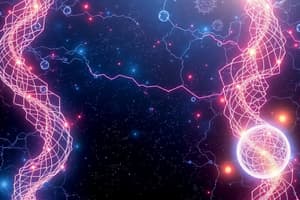Podcast
Questions and Answers
What is the primary role of bioenergetics?
What is the primary role of bioenergetics?
- To break down ATP into ADP and inorganic phosphate.
- To convert macronutrients into usable forms of energy. (correct)
- To transport energy directly to the muscle tissues.
- To facilitate the storage of energy in fat cells.
Which molecule directly powers almost all cellular processes requiring energy?
Which molecule directly powers almost all cellular processes requiring energy?
- ATP (correct)
- Glucose
- ADP
- Glycogen
What is the primary purpose of the body's other energy stores, besides ATP?
What is the primary purpose of the body's other energy stores, besides ATP?
- To power short bursts of activity directly.
- To act as pre-cursors of hormones.
- To provide insulation and protection of organs.
- To replenish ATP through the phosphorylation of ADP. (correct)
In which cellular location does the phosphagen system primarily function?
In which cellular location does the phosphagen system primarily function?
Which of the following statements best characterizes the energy systems during exercise?
Which of the following statements best characterizes the energy systems during exercise?
Which energy system provides the fastest rate of ATP production?
Which energy system provides the fastest rate of ATP production?
Under what conditions is the availability of the energy system's molecules best classified?
Under what conditions is the availability of the energy system's molecules best classified?
What is an example of a pacing strategy that would NOT be ideal based on the information provided?
What is an example of a pacing strategy that would NOT be ideal based on the information provided?
Which of the following best describes the relationship between energy systems and exercise?
Which of the following best describes the relationship between energy systems and exercise?
What is the primary role of creatine kinase in the phosphagen system?
What is the primary role of creatine kinase in the phosphagen system?
If an athlete is performing a high-intensity exercise, approximately how long can the phosphagen system provide ATP?
If an athlete is performing a high-intensity exercise, approximately how long can the phosphagen system provide ATP?
Which of the following is accurate about energy system usage?
Which of the following is accurate about energy system usage?
What does 'efficiency' refer to in the context of energy systems?
What does 'efficiency' refer to in the context of energy systems?
Based on the provided information, what determines which energy system is primarily utilized?
Based on the provided information, what determines which energy system is primarily utilized?
How is glucose utilized to create energy by the body?
How is glucose utilized to create energy by the body?
What is a common misconception about how energy systems work?
What is a common misconception about how energy systems work?
Flashcards
Bioenergetics
Bioenergetics
The process of converting macronutrients (carbohydrates, fats, and proteins) into energy that the cells can use.
Energy
Energy
The ability to do work. It can be stored (potential energy) or used to perform an action (kinetic energy).
ATP (Adenosine Triphosphate)
ATP (Adenosine Triphosphate)
The primary energy source for all cellular processes. It stores and releases energy through the breakdown of its phosphate bonds.
Energy Systems
Energy Systems
Signup and view all the flashcards
Phosphagen System
Phosphagen System
Signup and view all the flashcards
Glycolytic System
Glycolytic System
Signup and view all the flashcards
Oxidative System
Oxidative System
Signup and view all the flashcards
Exercise Intensity and Energy Systems
Exercise Intensity and Energy Systems
Signup and view all the flashcards
Intensity determines energy system
Intensity determines energy system
Signup and view all the flashcards
Energy systems are not "on" or "off"
Energy systems are not "on" or "off"
Signup and view all the flashcards
Phosphagen system duration
Phosphagen system duration
Signup and view all the flashcards
Energy system contribution
Energy system contribution
Signup and view all the flashcards
Energy system efficiency
Energy system efficiency
Signup and view all the flashcards
Study Notes
Bioenergetics
- Bioenergetics is the conversion of macronutrients into usable energy forms.
- Energy is the ability to perform work.
- ATP (adenosine triphosphate) powers all energy-requiring cellular processes.
- Other energy stores are used to replenish ATP by ADP phosphorylation.
Biological Energy Systems
- Three basic energy systems exist in muscle cells to replenish ATP:
- Phosphagen (sarcoplasm): Phosphocreatine, glucose/glycogen, glycerol, amino acids.
- Glycolytic (sarcoplasm): Phosphocreatine, glucose/glycogen, glycerol, amino acids.
- Oxidative (mitochondria): Fatty acids, pyruvate from glucose, some deaminated amino acids.
- The rate of ATP production depends on intensity of activity while duration is secondary consideration
Fuel Substrates Rate vs. Capacity
- Phosphagen:
- Location: Sarcoplasm
- Oxygen necessary?: No
- Rate of ATP per second: 10
- ATP per molecule of substrate: 1
- Available capacity: <15 sec
- Oxidative (from carbs):
- Location: Mitochondria
- Oxygen necessary?: Yes
- Rate of ATP per second: 2.5
- ATP per molecule of substrate: 32-33
- Available capacity: ~90 mins
- Oxidative (from fat):
- Location: Mitochondria
- Oxygen necessary?: Yes
- Rate of ATP per second: 1.5
- ATP per molecule of substrate: >100
- Available capacity: days
Review Questions
- Understand how energy systems rank regarding speed and efficiency of ATP production.
- Efficiency refers to the number of ATP molecules generated per substrate.
- Apply bioenergetics information to different exercises and sporting events with varying intensities.
Key Points
- The three energy systems contribute to ATP production depending on intensity.
- No single energy system provides complete energy supply, either during exercise or rest.
Studying That Suits You
Use AI to generate personalized quizzes and flashcards to suit your learning preferences.




